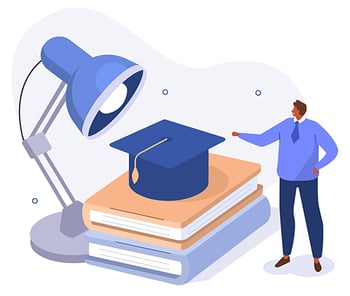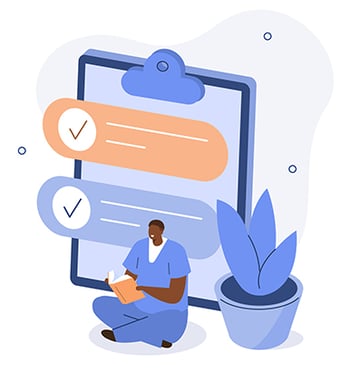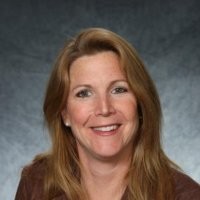Five Tips To Integrate The First-Year Experience on Campus - In this article guest author Dr. Laurie Hazard shares her views to support students and deliver effective First-Year-Experience programs on campus. For more FYE resources, check out some of our recent webinars, including 'Mastering Executive Functioning Skills: A Key To Academic Success' featuring Dr. Laurie Hazard.
WEIGH Your Options: Five Tips for Integrating the First-Year Experience on Campus
Introduction
Is your first-year experience classified as "high impact"? We define "High Impact Practices" or "Best Practices" as sets of educational strategies proven to significantly enhance student success and retention. Notably, programs like first-year experiences and student success courses play a crucial role in assisting students in navigating the transition from secondary education to college. The ultimate objective is for these experiences to substantially contribute to student success.
While many of the programs have proven effective, the pandemic highlighted the need for colleges and universities to reconceive their practices and rethink current approaches. In today's higher education landscape, institutions face the challenge of not only developing courses and programs that will work most effectively for their campuses' demographics, culture, and climate but also accepting that there is no 'one-size-fits-all' approach to enhancing student success.
Now is the time for colleges and universities to WEIGH their options, innovate, and find ways to intentionally integrate the first-year experience on campus. They can do this by starting with the WEIGH acronym, which stands for:
- What is most worth knowing?
- Examine what is already happening on your campus
- Initiate and pilot new programs and services
- Gains consolidation and program and services assessment
- Help support your student success colleagues
First and foremost, colleges must grapple with the enduring question in curriculum development: What is Most Worth Knowing? In other words, what knowledge and skills are imperative for students to succeed at your institution? Once this foundation is established, take a closer look at the innovative initiatives occurring on college campuses nationwide. Explore the strategies your colleagues are already implementing in the first-year experience at your institution. Encourage creativity and the initiation of new programs and services, always recognizing the potential for improvement. Provide faculty and staff with the autonomy to experiment with novel approaches. Evaluate the current effectiveness of student success practices and identify areas for enhancement. Gains should be assessed, programs and services refined, and a relentless focus on continuous improvement maintained. Lastly, extend support to your student success colleagues, recognizing the substantial effort required to design comprehensive first-year experience programs. Student success practitioners need ongoing professional development and access to valuable resources.

Let's now delve into each of these steps, exploring in detail how you can enhance the first-year experience by incorporating the principles of the WEIGH acronym.
What is most worth knowing?
It is widely accepted that first-year experience courses and programs have a positive influence on persistence and student success, particularly from the first year to the sophomore year. Among the common positive outcomes are the development of students’ sense of belonging and acceptance by cultivating a connection with the institution, helping familiarize students with campus resources and services, teaching academic and study skills, providing academic planning and advising, and honing critical thinking skills.
Institutions need to carefully consider the shared goals, objectives, and practices in student success and the first-year experience that prove effective for their unique context. This involves taking into account the distinctive features of the institution. Specifically, what knowledge and skills do students need to thrive at your institution, and how will this information be effectively delivered?
A good starting point is to reflect on the evolution of first-year experience models, explore their various types, and consider the demographics of your institution. Different models may include extended orientation, academic seminars covering various topics or uniform content, or a hybrid approach. Refer to the National Resource Center (NRC) for the First-Year Experience and Students in Transition. The NRC provides research and practical insights into how 'institutions of higher education support successful and equitable student transitions.' Review their past National Surveys on the First-Year Experience, and keep an eye out for the upcoming one slated to be published this year.
In addition to determining the model, you will need to initiate an institution-wide conversation that delves into the shared goals, objectives, and practices in student success and the first-year experience, tailored to work seamlessly within your institution. Factors such as institution type, student population, academic programs offered, fiscal health of your budget, and faculty-to-student ratios must be considered. Leveraging your institutional data will empower you to discern what is most worth knowing for students at your institution.

Examine what is already happening on your campus
Positive efforts are underway in student success and the first-year experience at institutions nationwide. However, even at smaller institutions, faculty, staff, and administrators can become so engrossed in their own roles that they may not be fully aware of the daily initiatives taking place in different departments and divisions to enhance student success.
As noted by Koch and Gardner (2006), “The first-year experience is not a single program or initiative but rather an intentional combination of academic and co-curricular efforts within and across postsecondary institutions.” Does someone at your institution have comprehensive knowledge of all the student success efforts in progress? Is there a designated individual overseeing these efforts and ensuring that key stakeholders are well-informed about them?
Every few years, it's beneficial to conduct an institutional “inventory” to assess ongoing practices and identify potential areas for improvement. Scrutinize your orientation, first-year seminar, and advising for first-year students. Explore the presence of learning communities or residential experiences. Evaluate your early alert system and consider whether you've implemented a common read or embraced the emerging trend of partnering with parents and families to enhance student success initiatives. Examine whether your practices are seamlessly integrated or if there are stand-alone efforts. While consulting research and best practices is valuable, it's equally important to be attuned to what's happening at your own institution. Tap into the professional practice knowledge of individuals involved in the operational side of your student success and retention practices.

Initiate and pilot new programs and services
Avoid change for change's sake; instead, focus on thoughtful improvements. While change can sometimes induce anxiety, in many cases, the benefits of trying something new outweigh the costs. Introducing a new initiative can yield numerous benefits. Pilots help determine if theoretical strategies are practical, fostering a culture of creativity, growth, and experimentation. They inform decision-making and enable institutions to troubleshoot before scaling up a new program. One of the best aspects of a new initiative or pilot is that it encourages faculty, staff, and administrators to collaborate toward a shared goal. Remember, a new program or service doesn't have to be a major undertaking. Consider trying something with a specific population of students. For instance, if your student success practitioners identify a gap in services for commuters, design a solution to address the challenge. Investigate current trends in the first-year experience and student success, exploring what institutions with similar demographics are doing, and experiment with those ideas.
Ask key questions along the way:
- Is the pilot/initiative working?
- What has been the impact so far?
- How have faculty, staff, and administrators adjusted?
- What needs to be done for continuous improvement efforts?
- What are the costs and benefits of the new pilot/initiative?
Avoid change for change's sake; instead, focus on thoughtful improvements.
Gains: Assess your programs and services and consolidate gains
Assessment plays a pivotal role in facilitating continuous improvement efforts. Develop an assessment plan to gauge the effectiveness of your first-year experience and student success and retention initiatives for ALL students. Scrutinize assessment data and practices at various levels, including the course, program, and institutional tiers. On the institutional level, analyze metrics such as student persistence, graduation rates, academic achievement, and grade point averages. Delve deeply into outcomes for specific populations, such as first-generation students. Craft reflection questions for assessment. For instance, your first-year experience course might have outcomes related to critical thinking.
Consider these course-level questions:
- Are we teaching what we think we are teaching?
- Are students learning what they are supposed to be learning?
- Is there a way to teach our subjects better, thereby promoting better learning?
- If assessment is an integral part of instruction, are we using it effectively to determine whether the goals of our institution’s education are being met?
- Are we using assessment appropriately to determine instructional needs and to improve curriculum and course design?
Recognize that assessment comes with its challenges. Many institutions often cite a shortage of personnel and time constraints as common hurdles. It's crucial to acknowledge that robust assessment initiatives require professional development and adequate resources. To navigate these challenges effectively, consider implementing a yearly 'assessment loop' plan:
- Conduct assessment to understand student success indicators.
- Analyze the information to support continuous improvement efforts.
- Develop an action plan based on the results.
- Implement your plan for the upcoming academic year and hold stakeholders accountable.

Help support your student success colleagues
Designing comprehensive first-year experience programs and being on the front lines with first-years is undoubtedly a substantial endeavor. Student success practitioners require professional development, moral support, and resources to navigate this challenging landscape. While we are familiar with the concept that it's crucial to take care of ourselves before effectively caring for others, we don't always prioritize it. Those in helping professions within higher education—such as teaching, counseling, tutoring, advising, and student engagement—understand the potential for high stress and burnout. Nevertheless, we venture into the realms of student success and student affairs fueled by a passion to help students thrive and discover their paths.
Since the onset of the pandemic, numerous conference presentations, discussions, and articles have centered around the critical issue of burnout and self-care (such as this example). These efforts aim to help faculty, staff, and administrators address a significant challenge in higher education: finding effective ways to care for the individuals responsible for our students. Despite the increased focus on promoting self-care and addressing burnout, many institutions still lack well-developed plans to tackle this issue. Why not consider developing a pilot program? Invest in resources and professional development for staff, and create innovative ways to engage faculty, staff, administrators, and students in supporting each other while committing to organizational change.
The pandemic emphasized the necessity for institutions of higher education to reevaluate their approach to student success and the first-year experience. It's time to move beyond the “one-size-fits-all” model and explore creative strategies to “meet students where they are at,” prioritizing individual needs. To initiate enhancements in your FYE program, consider employing the WEIGH acronym as a guide for improving your programs.
About the Author
Dr. Laurie L. Hazard, Ed.D.
Founder, Recognize Your Potential
Educator, Counselor, Student Success Expert
www.lauriehazard.com
www.Offtoseries.com
Laurie Hazard is an award-winning educator and nationally recognized student success expert who researches how students make successful transitions from secondary to higher education. She studies and writes about student personality types, academic achievement, and classroom success. For more information on Laurie's speaking, writing, and consulting: www.lauriehazard.com.
